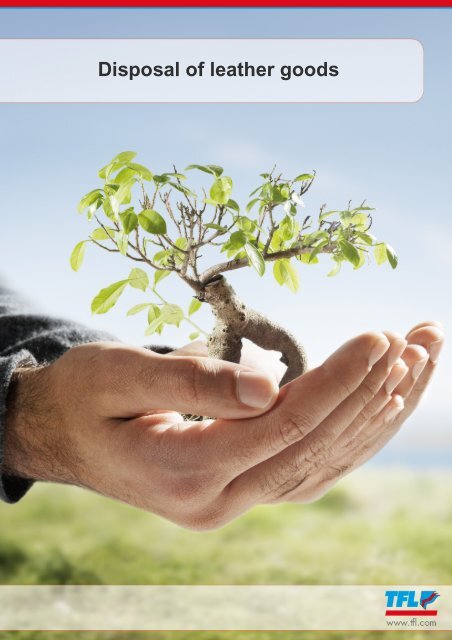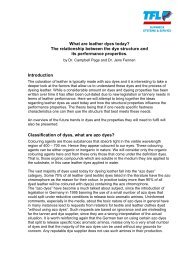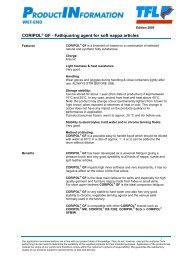Disposal of leather goods (pdf / 1434 KB) - TFL
Disposal of leather goods (pdf / 1434 KB) - TFL
Disposal of leather goods (pdf / 1434 KB) - TFL
You also want an ePaper? Increase the reach of your titles
YUMPU automatically turns print PDFs into web optimized ePapers that Google loves.
<strong>Disposal</strong> <strong>of</strong> <strong>leather</strong> <strong>goods</strong>
Introduction<br />
<strong>Disposal</strong> <strong>of</strong> <strong>leather</strong> <strong>goods</strong><br />
by<br />
Dr. Alois Puentener<br />
Quality & Environment<br />
The consumer has a responsibility not to use the simplest method <strong>of</strong> disposal -<br />
unfortunately still in common practice - that is, just throwing refuse away. Campaigns to<br />
collect worn and unwanted <strong>goods</strong> and sporadic recycling initiatives go some way towards<br />
improving the situation. However the best solution would be to make new material or<br />
products from recovered <strong>leather</strong>. The second best way to dispose <strong>of</strong> used <strong>leather</strong> is by<br />
incineration, because <strong>leather</strong> provides considerable amounts <strong>of</strong> energy. But this leaves the<br />
problem <strong>of</strong> dealing with the slag.<br />
Nature <strong>of</strong> problem<br />
The simplest method <strong>of</strong> disposal is to return the used natural product <strong>leather</strong> to nature, e.g.<br />
to compost it. We are therefore studying this carefully. Some initial progress has been<br />
achieved. We have ascertained that organic material like dyes or pigments, retanning<br />
agents, fat liquor may degrade under given biological conditions. However, chrome tanned<br />
<strong>leather</strong> is hard to compost and the reaction <strong>of</strong> the remaining metal, which may includes<br />
some inorganic pigment and metal from complex dyes, is not known in detail. Therefore, at<br />
the present time composting trials are mostly performed with metal-free shavings or <strong>leather</strong><br />
waste. The composition <strong>of</strong> a typical wet white shaving waste is shown in table 1.<br />
Table 1: Composition <strong>of</strong> wet white pre-dried<br />
Water content 10 %<br />
Total dried matter (105°C) 89.7 %<br />
Total organic dried matter (combustion) 89.0 %<br />
Phosphorus (as P2O5 ,calculated) 0.01 %<br />
Potassium (as K2O ,calculated) 0.04 %<br />
Calcium (as CaO ,calculated) 0.2 %<br />
Magnesium (as MgO, calculated) 0.003 %<br />
Nitrogen (as N, calculated) 15.1 %<br />
1
Composting method<br />
Wet white waste before composting<br />
Compost, normally placed in a shady corner, is the heart <strong>of</strong> a biological garden. It requires<br />
heat, moisture and oxygen in order to react aerobically (oxidatively). The compost shown in<br />
table 2 was used in a field test:<br />
Table 2: Composition <strong>of</strong> standard compost<br />
Greenery 4'500 kg<br />
Fruit waste 500 kg<br />
Wet white shavings and trimmings 320 kg<br />
Initial compost 50 litres<br />
Stone powder 30 kg<br />
Water 330 litres<br />
The compost behaved like a natural garden compost. The reaction process is triggered by<br />
micro-organisms and takes place in three stages (heating, hot stage, cooling) at different<br />
temperatures over a total period <strong>of</strong> about approximately 6 months. The reaction mass<br />
heats up to a maximum <strong>of</strong> 70-80°C, thereby harmful biological substances are being<br />
destroyed. The earth organisms then require nitrogen in order to build up their own protein.<br />
In biological enterprises, especially in autumn, when foliage, wood and shrub waste occurs,<br />
there is <strong>of</strong>ten too little nitrogen present, and it frequently has to be added. We have seen<br />
that metal-free shavings or metal-free <strong>leather</strong>, added at the beginning <strong>of</strong> the composting<br />
process, can provide this additional nitrogen.<br />
However, every compost composition shows behaves differently. Therefore the general<br />
guideline shown in table 3 should be followed for composting <strong>leather</strong> waste and in<br />
selecting chemicals used for producing metal-free <strong>leather</strong>.<br />
2
Table 3: Composting guideline<br />
1 Shavings or <strong>leather</strong> waste must be composted together with other organic natural<br />
material.<br />
2 Shavings or <strong>leather</strong> waste must be reduced to very small pieces and care taken to<br />
make sure that the compost is very well mixed.<br />
3 Aliphatic compounds like natural fat decompose faster than aromatic products<br />
like synthetic syntans.<br />
4 Products <strong>of</strong> low molecular weight are easier to destroy than those <strong>of</strong> high<br />
molecular weight or even cross-linked products which are <strong>of</strong>ten used for the<br />
finishing process.<br />
5 Avoid problematic chemicals like chlorinated paraffin, nonyl-phenols, some<br />
preservatives and others.<br />
Results<br />
The results <strong>of</strong> various studies carried out show that excellent compost with a high nutrient<br />
content is obtained by this method. The assumed average analysis <strong>of</strong> the compost<br />
including <strong>leather</strong> waste is shown in table 4:<br />
Table 4: Compost analysis<br />
1 pH 6-8<br />
2 Water content 40-50%<br />
3 Organic matter 45-55%<br />
4 Nitrogen (measured on try contains) 1.5 -2.0 %<br />
5 Heavy metal content: i.e. cadmium and mercury less than 1ppm<br />
Heavy metal content: i.e. lead, chromium copper, less than 100ppm<br />
and nickel<br />
Field tests with this compost revealed that nitrogen was released to the soil at a slow rate,<br />
therefore this compost has to be classified as a long term nitrogen fertiliser. This is a very<br />
clear indication that <strong>leather</strong> is (and should be) a highly stable material. Too much <strong>leather</strong> in<br />
the compost can slow down the fertilising effect. The heavy metal content should be low to<br />
meet the strict limits set by experts and authorities.<br />
3
Conclusion<br />
Wet white must be reduced by a shredding machine<br />
Experience to date indicates that on the strength <strong>of</strong> these results we can feel justified in<br />
hoping to have found an environmentally acceptable disposal procedure for chrome-free<br />
shavings and <strong>leather</strong>. In principle, metal free shavings and <strong>leather</strong> have been found not to<br />
inhibit the biological process <strong>of</strong> composting and can be used as fertiliser. However, it must<br />
be borne in mind that <strong>leather</strong> is <strong>of</strong>ten produced with unknown chemicals, which may slow<br />
down the composting and fertilising behavior. For every type <strong>of</strong> <strong>leather</strong> trials should be<br />
carried out and be verified by drawing up integral environmental balance sheets.<br />
Acknowledgements<br />
Controlling <strong>of</strong> the composting process with the appropriate tool<br />
I would like to say thank you the many contributors who have helped in the writing <strong>of</strong> this<br />
paper.<br />
Updated 5.Jan.2004/AP<br />
4






